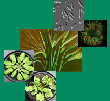| Weber, M; Harada, E; Vess, C; von Roepenack-Lahaye, E; Clemens, S: Comparative microarray analysis of Arabidopsis thaliana and Arabidopsis halleri roots identifies nicotianamine synthase, a ZIP transporter and other genes as potential metal hyperaccumulation factors, Plant Journal, 37, 269-281 (2004), doi:10.1046/j.1365-313X.2003.01960.x | |
| Abstract: The hyperaccumulation of zinc (Zn) and cadmium (Cd) is a constitutive property of the metallophyte Arabidopsis halleri. We therefore used Arabidopsis GeneChips to identify genes more active in roots of A. halleri as compared to A. thaliana under control conditions. The two genes showing highest expression in A. halleri roots relative to A. thaliana roots out of more than 8000 genes present on the chip encode a nicotianamine (NA) synthase and a putative Zn2+ uptake system. The significantly higher activity of these and other genes involved in metal homeostasis under various growth conditions was confirmed by Northern and RT‐PCR analyses. A. halleri roots also show higher NA synthase protein levels. Furthermore, we developed a capillary liquid chromatography electrospray ionization quadrupole time‐of‐flight mass spectrometry (CapLC‐ESI‐QTOF‐MS)‐based NA analysis procedure and consistently found higher NA levels in roots of A. halleri. Expression of a NA synthase in Zn2+‐hypersensitive Schizosaccharomyces pombe cells demonstrated that formation of NA can confer Zn2+ tolerance. Taken together, these observations implicate NA in plant Zn homeostasis and NA synthase in the hyperaccumulation of Zn by A. halleri. Furthermore, the results show that comparative microarray analysis of closely related species can be a valuable tool for the elucidation of phenotypic differences between such species. |

last modified 2021-05-17

